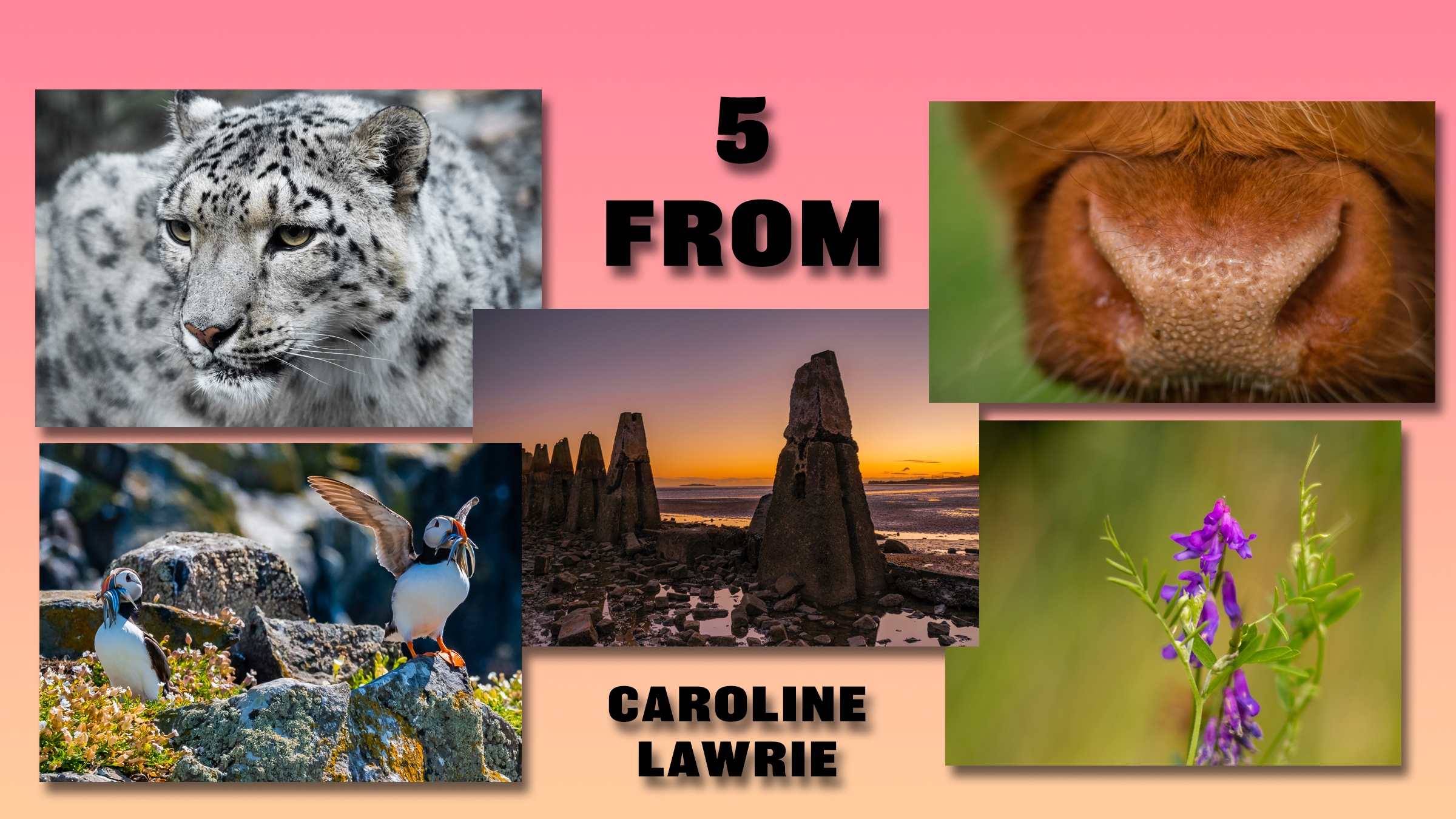December 1, 2021
Five from…. Caroline Lawrie
The second edition of looking at five photos from a past attendee of an Edinburgh Photography Workshop session

Every couple of months, I am looking to feature the photographs of somebody who has joined me in a photography workshop. In September, David Keenan shared his photos, and I know that he got a lot from the feedback. This month, we have another five photographs provided by Caroline Lawrie. Before we look at her photos, I have asked Caroline to share a little bit about her and her photographic journey.
Who is Caroline Lawrie?
“ I have always liked taking photos to capture events in time but just snapshots. I always thought real photography was complicated, so I just hoped photos would come out ok. During lockdown, I got my bridge camera out and on my daily one hour walk, decided to capture the changing seasons on the estate I live on, and started noticing all the wildlife and plants on the doorstep, always on auto as no idea what any of the other things were!
For my 50th last year, my brother got me a voucher for the Switch to Manual course in Oct 2020, which was great and opened my eyes to trying to improve my photos so they looked more like the way I thought they should. By Dec 2020, I got a second-hand DSLR and a couple of lenses and started reading up on how to take mainly photos of wildlife, I got a Nikon D3500, and by April, I had traded this in with a couple of lenses and upgraded to the D500. At that point, I also started the OU improving your digital images course, which was great and got me using different techniques and subjects, too though wildlife is my favourite, with landscapes a close second. I have done the landscapes and seascapes course and most recently the Night Photography course, so lots of technical things to remember when I get out. My one regret is that I did not get into this years ago as I really enjoy it.”
Photo 1 – Puffins
We’ll start Caroline’s portfolio review with a shot of a couple of puffins (I am guessing) on the Isle of May. These little birds are so photogenic, and they always raise a smile with their colourful beaks. It’s always nice to get a shot with a puffins beak filled with sand-eels, and to get two must make Caroline very proud. I enjoy the way the two birds are positioned to show opposing characters. The one on the left sits nonchalantly while the puffin on the right appears to be celebrating their catch. Part of wildlife photography is having the patience to wait for the perfect moment, and Caroline has certainly done that.

There are one or two changes that I think might make this excellent photograph a little bit better. The first is removing distractions that don’t need to be in the frame. The shot was taken just after noon in mid-June – probably not the best time of the day to shoot, but I do know that visiting the Isle of May is reliant on the sailing times of boats, so this is unavoidable. However, a rock in the bottom left of the shot is drawing my eyes to it. Our brains are attracted by the brightest thing in an image, so I am drawn away from the two subjects that should be the focus. A slight crop can remove this from the shot. Secondly, the two birds are a little dull, again, caused by the harsh mid-day light. Using the select subject tool in Photoshop or Lightroom, we can pull out a little more detail and brightness to make them stand out from the shot. These minor tweaks lift the photo, but Caroline should be rightly proud of this first image.

Heilan’ Coo Nose
The next photo gives a different perspective on another of Scotland’s creatures, the Highland Cow, and it’s good to see Caroline trying something unusual. The vibrant red hair obviously points to what the subject is despite the unique view. We can see every detail of the pits in the front of the cow’s snout. The shallow depth of field is created with a wide-open aperture (f/2), and the close position feels just a wee bit too narrow. I would like to see slightly more of the image in focus.

There are two things I would consider if I were taking a similar image. The photo feels lop-sided with the green grass on the left-hand side, and I would try and crop as much out of this as possible. More importantly, though, is the focus of the subject. Before I started to write the review, but after I had considered the images, I asked for a second opinion. We both had the same initial reaction that the nose didn’t feel like a pleasing place to be drawn to. While it’s probably the more cliched image, including the fringe above the eyes and a wider depth of field would have made a better shot. I am sure that some might like the individuality of Caroline’s view. That is why it’s good to remember that any critique is a personal opinion and not a factual declaration.
Harebell
I’m not a flower expert, so I hope that I have named this pretty flower correctly. Caroline has again used a shallow depth of field to create some lovely bokeh behind the flower. However, I think this may be the weakest of the five photos submitted. I am often critical of ‘camera club’ judges who state that they would change the conditions to provide feedback on an image, and I’m now going to do exactly what they say!

The subject of the shot is clearly the taller of the two flowers. Unfortunately, about half of the petals are covered by the greenery sitting in front, either wholly or partially. I find this very distracting, and I would prefer to see the stem removed from the shot at the scene. You can do this by a bit of gardening or by moving the shooting position. Similarly, the second flower is not in the best condition. Perhaps being there a day or so earlier would have made a better shot.
A more important issue in this image is the over-sharpened feel the edges of the flower have. I initially thought that Caroline had been over-zealous in sliding the Sharpen slider in Lightroom, but as I had access to the EXIF data, I could see the issue with the image. There is an awful lot of cropping required to get the composition submitted. Sadly, in this case, it has quite significantly impacted the quality of the image.
Cramond Causeway
I know Cramond very well, and I have shot this scene many times. Caroline has timed her visit to coincide with some fantastic conditions just before sunrise. I like that Caroline has taken care to position the single sea defence between the mainland and the island of Inchkeith. I think it would be better if Caroline took a few steps to the right so that she could exclude the pathway that is just creeping into the corner. Often on my Switch to Manual workshop, I talk about ‘border control’, the act of looking at the edges of the image to see if something feels like a viewer may think it’s a mistake to include it.
Another enhancement that Caroline might want to consider is to slightly open up the shadows in the sea defences and then retain contrast by increasing the blacks in the image. I have tried to show how these two suggestions may look below. The original edit is on the left, and you can reveal the suggestion by sliding the bar.
While perhaps it may not be visible on the smaller image included in the blog, there is a slight issue visible in the edges of the stones. There appears to be some ghosting either caused by not ticking the ‘Remove Chromatic Aberration box in Lightroom or, more likely, through camera movement when taking the shot. Particularly when taking long-exposure photos, it is always worth using a shutter release to reduce the likelihood of camera shake.
Big Cat
To finish off the review of Caroline’s pictures, I have left what I think is, by far, her best shot of the five. I think it is a leopard based on its spots. The choice of aperture (f/7.1) is perfect, with the eyes tack sharp and good detail from the front of the nose to the top of the front ear. The torso of the cat then frames the head with glorious bokeh. There is little to criticise with this shot, but if I wanted to be incredibly picky, I would like to have seen a slight separation between the bac ear and the top of the frame. It is a cracking shot! Well done, Caroline.

Give us your feedback
I hope you have enjoyed this second in what I hope will be an ongoing series of portfolio reviews. Caroline has only been shooting for just over 12 months, and she should be rightly pleased with her progress. The big cat shot, in particular, is one that I would be happy to have taken. Have you attended an Edinburgh Photography Workshop session and would like to see your best five photos reviewed? Drop me a mail with a short biography, as Caroline did, and five full-sized images with EXIF data attached.
If you’ve got any questions or comments, leave them below. You can sign up for the Edinburgh Photography Workshop monthly newsletter, where you’ll get regular updates on exciting things happening in photography and some great tips. Sign up by clicking here.
About the author
As well as running Edinburgh Photography Workshop, Rich Dyson is a professional photographer. His photographs are regularly used in newspapers such as The Times, Guardian and Daily Telegraph. He also had two solo exhibitions as well as being featured in a members sponsored exhibition in the Scottish Parliament. You can see and buy his photography at richdysonphotography.com
